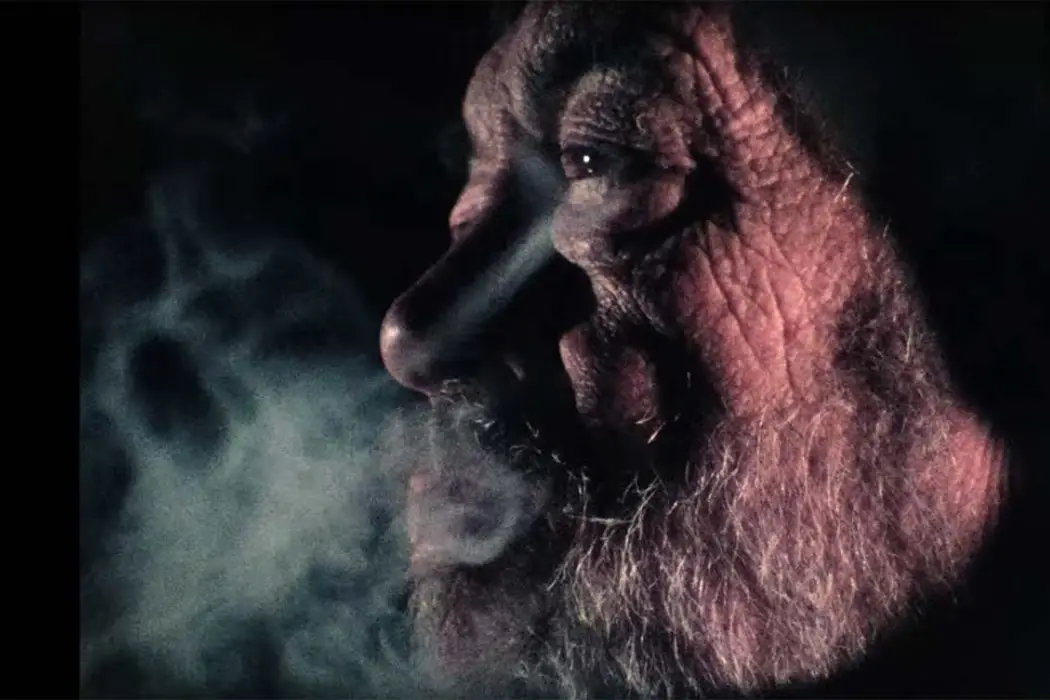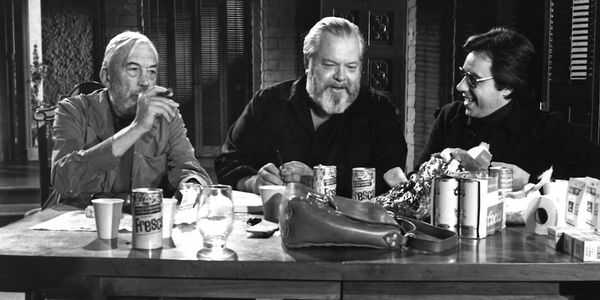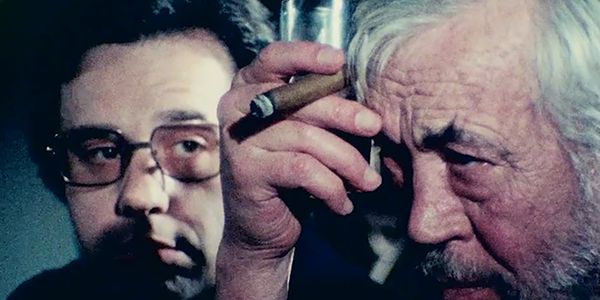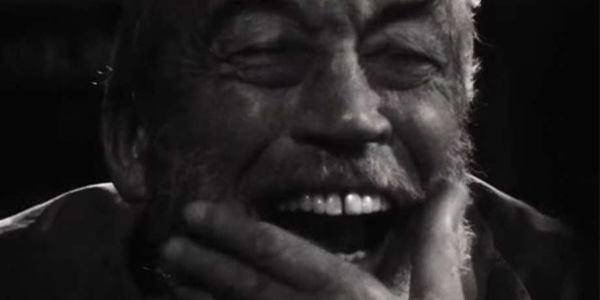THE OTHER SIDE OF THE WIND: A Must See For Welles Devotees & No One Else

Nathan is a 22 year old writer and film lover…
During his career, Andy Warhol expressed a belief that his films were more interesting to talk about than they were to actually watch. While that might serve as an explanation for his lengthy, minimalist, and extemporaneous films like Blow Job or Sleep, it comes across as a measured compliment when addressed to films with professional actors and plots. The Other Side of the Wind, however, is ripe for measured compliments. While the film is passable, its greatest asset is that it is a goldmine for disciples of Welles who will be ensorcelled by him attempting more modern aesthetics and discussing the film world of the 1970’s.
The Traps of being Autobiographical
The Other Side of the Wind follows Jake Hannaford (John Huston) – a filmmaker with a cult of personality who was fallen out of favor in Hollywood – as he screens his upcoming film (titled The Other Side of the Wind) in the hope of attracting investors. This story is closely entangled with the film itself and its director Orson Welles, even to the extent that Jake Hannaford has a younger and more successful director friend played by Welles’s own younger and more successful director friend, Peter Bogdanovich. While there is never a one-to-one connection between the film and Welles’s life, the similarities are great enough to lay the legend of Orson Welles upon the film, a heavy weight for any film to carry.
For anyone who buys into the legend of Orson Welles, this almost autobiographical feeling can be tantalizing. It is exciting to see these caricatures of the 1970’s film world and wonder which of Hannaford’s aphorisms are advice from Welles and which are attempts to parody the mystic of the troubled artist. If you don’t care about Welles, this will probably feel self indulgent and a little uninspired. As someone who likes Welles but doesn’t adore him, I was simultaneously intrigued and frustrated.

As the film goes on, Hannaford grows more erratic and drunk while the film reveals a litany of his personal and professional inadequacies. To a certain extent, this feels like Welles chafing against his own mythology and the mythology of tortured artists. It is important to note that in having John Huston play Hannaford, Welles picked a director with a similarly oversized public legend. What’s more, it is a persona even more firmly built on the machismo Welles lampoons through Hannaford.
Despite these critiques, the film attempts to have it both ways because even as the myth of Hannaford is undermined, the film rests on his charisma. It is painful to watch a writer or director put in a character they identify with that is supposed to be real frigging cool and this film is no exception. There are multiple times when it falls guilty to the sin of making people laugh at a joke clearly from the mouth of the writer.
An Eye For Style
I was excited to hear that The Other Side of the Wind was a mockumentary because I was blown away the first time I saw F for Fake and was excited to see what else Welles could do in and around documentaries. To his credit, The Other Side of the Wind does an excellent job of blending into the documentary aesthetic and appearing as a found footage without the clearly personal aesthetic touches of F for Fake. That said, what a silly move.

For the life of me, I don’t know why Welles thought it was smart for him to hide his aesthetic sense under a bushel. While there are moments in the documentary that look truly beautiful, they are far outnumbered by the shots that look haphazard or banal. This haphazard banality may work well with Welles’ goals, but they do not make for a fun experience.
The look of the film, and especially the film’s editing, show an awareness of the films made during his career with him drawing from the French New Wave and Fellini (and perhaps even the New York avant-garde scene). At the film’s best moments, Welles shows himself a contemporary and a part of current (for the time of filming) filmic dialogue rather than a relic of the past. More often, however, the film feels derivative. There is enough good in this film to inspire thoughts about what his next three films would have been, but not quite enough to stand on its own.
The Titular Film Within a Film
In The Other Guys, Mark Wahlberg’s character has spent countless hours learning different complicated and intricate tasks (such as ballet dancing) for the singular purpose of making fun of those who perform that task. Put more plainly, he would masterfully dance in order to make fun of dancers. This appears to be the logic behind the titular film within a film in The Other Side of the Wind.
Hannaford’s film is an atmospheric film full of geometrically dense compositions, erotic ambiguity, and silence. It rotates between lampooning contemporary European filmmaking and highlighting Welles’s eye for beauty and depth, often resting somewhere in the middle. To be clear, this lampooning will never make you laugh. At best, you will nod and remember something from L’Avventura which is less fun. It is not always clear whether Welles is trying to say that tonal films are dumb or trying to show that he can do it just as well as anyone else.

I am not entirely sure why Welles would feel such a need to lash out against a branch of art films. If anyone has ever been indebted to European snobs, it’s Welles.
This unsuccessful meandering between the parodic and the genuine is perhaps nowhere more strongly shown than when the two leads of the film within the film have sex in a car. It ain’t funny, but it sure ain’t sexy either. Welles’ earlier films were far more prudish, and this scene shows us what a mercy that was.
The actor’s ascetic performances might have come across as coy or self-possessed under a more sensual director, but instead look clunky and wrote. While I was left with the feeling that left to her own devices, co-writer and star Oja could be sensual as the day is long, the camera in The Other Side of the Wind is like a horny teenager that knows it loves breasts but doesn’t really know what to do about it. The scene, in many ways, feels like an attempt to prove erotic ability, but of course the whole reason that trying new things is terrifying is that we might fail as Welles does here.
The Other Side of the Wind: Conclusion
For a Welles completist, there is a lot here that will be very interesting. He certainly tries to do something new for him and addresses a lot of issues very close to his public persona in such a way as to litter this film with Easter eggs for anyone who cares to hunt them down. I don’t see this being very many people’s favorite film in his cannon, but for those wanting to watch the film in order to put a wrap on his filmography, this will not be a slog. If you don’t care about Orson Welles, this film does not stand up well enough on its own to be worth your time.
Do you have any films you like talking about more than watching? Let us know in the comments below!
The Other Side of the Wind is now available on Netflix.
Does content like this matter to you?
Become a Member and support film journalism. Unlock access to all of Film Inquiry`s great articles. Join a community of like-minded readers who are passionate about cinema - get access to our private members Network, give back to independent filmmakers, and more.
Nathan is a 22 year old writer and film lover in Philadelphia, PA.













